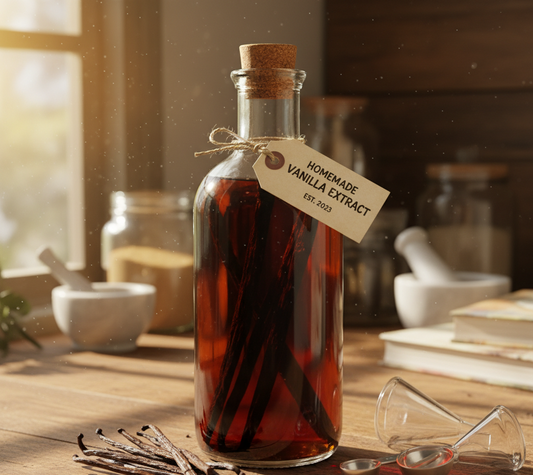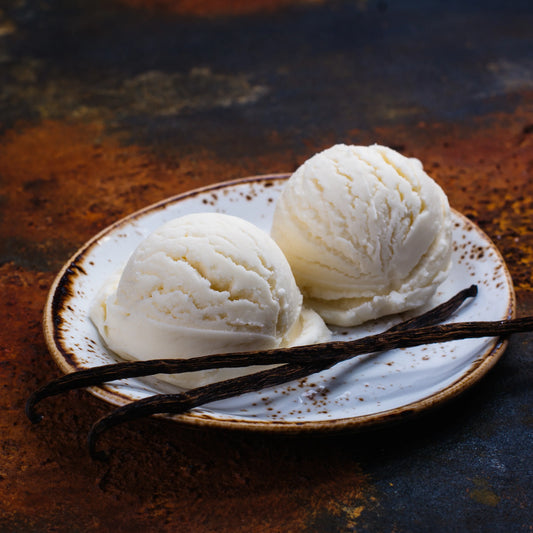BEANS VS. EXTRACT: WHY VANILLA BEANS REIGN SUPREME
Share
Unlocking the Superior Flavor and Sustainability of Vanilla Beans
Making the switch from vanilla extract to vanilla beans can transform your baking. But are premium vanilla beans really worth the cost and effort? Vanilla beans vs. vanilla extract - which should you use in your baking?
Vanilla beans impart a more complex, nuanced flavor that can greatly enhance desserts and baked goods; but they also come at a higher cost. Vanilla extract is more affordable and convenient, though some feel it has a simpler, more one-dimensional taste.
This article will compare and contrast vanilla beans and extract to help you decide which option may be better for your baking needs and budget. We'll explore the differences in flavor, cost, ease of use, and effectiveness in baking and cooking. Read on to learn whether premium vanilla beans are worth splurging on or if old reliable vanilla extract is sufficient before you bake your next batch of cookies.
What Makes Vanilla Beans So Special?
Vanilla beans offer two major advantages over plain old extract - unparalleled flavor complexity and superior quality.
Extract provides the quintessential vanilla taste, but beans bring so much more to the table. Each plump, fragrant pod contains over 300 aromatic compounds compared to a mere 100 found in extract. These include earthy, spicy, floral, and even raisin-like notes. As these nuanced flavors diffuse into batters, doughs, and custards, your treats blossom with multidimensional vanilla flavor.
In addition to expanded flavor, beans mean upgraded quality. Extract is made by soaking lower grade "scrap" vanilla beans in a solution of water and alcohol to draw out the flavor. Beans destined for extraction are rushed through curing and drying processes for speed.
In contrast, beans sold for direct use are carefully hand-pollinated and cured over months to develop the finest flavor. Slow, meticulous methods yield the best tasting beans; when you use these premium beans, you taste the time and care put into raising each one.
Why Support Sustainable Vanilla Beans?
Opting for whole vanilla beans over extract also benefits the environment. Although convenient, extract fuels vast demand for cheap vanilla often produced through unsustainable methods harming biodiversity.
Synthetic vanillin, made from wood pulp byproducts, also creeps into extract blends; sourcing quality vanilla beans directly from farms instead encourages sustainable practices preserving fragile ecosystems.
Buying fair trade organic beans nourishes hard-working growers. Your money goes further supporting ethical production. For superior flavor, quality, and sustainability, vanilla beans win every time.
Wait, Aren't Beans More Expensive Though?
You're right, the initial cost of beans far exceeds a bottle of extract. But don't let sticker shock discourage you because vanilla beans provide more bang for your buck in the long run.
Unlike spent extract, used bean pods can be rinsed, dried, and reused for a second (or even third) extraction. The seeds inside also get exponentially amplified when infused into recipes. A little bean goes a long way.
Pay the price over years of faithful use rather than a single batch, and beans become economically favorable; the unrivaled flavor will also convince you the splurge is worth it.
How To Choose the Best Vanilla Beans
With beans as your new go-to, this helps to know how to select top-notch pods:
Seek out beans that are plump and supple, not brittle or dried out. Oily, shiny beans still contain a full range of flavor compounds.
Check that the beans have no signs of mildew, such as white flecks. Uniform brown color indicates quality processing.
For peak freshness, buy whole raw beans instead of pre-ground and grind just before use.
Look for beans sourced from Madagascar, Mexico, Tahiti, or Uganda for premium flavor.
Certified organic and fair-trade beans ensure ethical, sustainable practices.
How to Store the Beans to Extend Shelf Life
Once home, proper storage preserves freshness. Follow these tips:
Keep beans in an airtight glass jar away from light, heat, and moisture.
Cover with a folded paper towel before sealing the lid to absorb excess moisture.
Store in a cool, dark cupboard or drawer, not the fridge. Refrigeration encourages mold.
With ideal storage, raw beans keep 1-2 years. Ground beans lose flavor faster, so grind as needed.
Ready To Make the Bean Switch?
Have we convinced you to ditch the extract for awesome vanilla beans yet? The proof is in the pudding - or cookies, cakes, and creams. Challenge yourself to make one recipe substituting beans for extract. We think you'll never look back after experiencing the flavor revelation!
What recipes will you try first with vanilla bean? Let us know if you make the switch from extract and how it goes!


